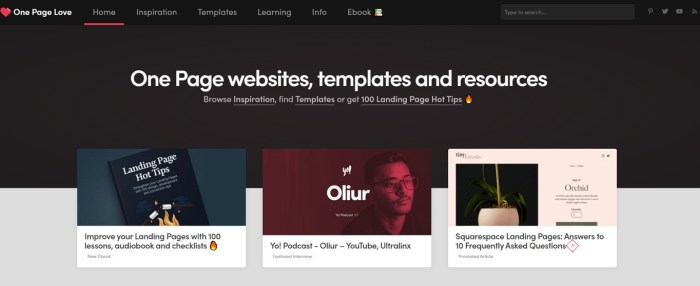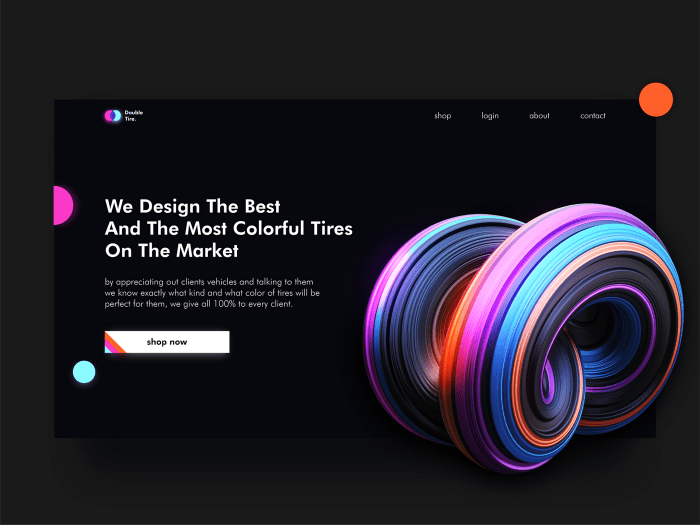Website Design Ideas: Get ready to dive into the latest trends, user experience essentials, color schemes significance, and innovative navigation menu examples. It’s time to level up your website game!
Website Design Ideas
When it comes to modern website design, there are several trends that are shaping the digital landscape. From minimalist layouts to interactive animations, here are some key design ideas to consider:
Modern Website Design Trends
- Sleek and Minimalist Layouts: Clean and simple designs that focus on essential elements.
- Mobile-First Approach: Designing for mobile devices first and then scaling up for desktop.
- Interactive Animations: Engaging animations to enhance user experience and storytelling.
- Dark Mode: A popular trend that reduces eye strain and adds a touch of elegance.
User Experience Importance
User experience plays a crucial role in website design as it directly impacts how visitors interact with your site. A seamless and intuitive user experience can lead to higher engagement, increased conversions, and improved brand perception.
Role of Color Schemes
The choice of color schemes in website design can greatly affect the overall look and feel of a site. Colors evoke emotions and can help convey brand identity. It is essential to choose colors that not only look visually appealing but also align with the brand’s message and target audience.
Innovative Navigation Menus
Navigation menus are a key component of any website, as they guide users through the site’s content. Innovative navigation menus, such as sticky menus, mega menus, or hidden menus, can enhance user experience and make it easier for visitors to find what they’re looking for.
Types of Websites

When it comes to websites, there are several different types that serve various purposes. Let’s explore the key features that make each type stand out and the importance of responsive design.
E-commerce Websites
E-commerce websites are online platforms where users can buy and sell products or services. Key features include a user-friendly interface, secure payment gateways, product categorization, and customer reviews. Examples of successful e-commerce websites include Amazon, eBay, and Etsy.
Portfolio Websites
Portfolio websites showcase an individual’s or company’s work and skills. Key features include a clean and visually appealing design, easy navigation, high-quality images or videos, and a contact form. Successful portfolio websites include Behance, Dribbble, and Adobe Portfolio.
Blog Websites
Blog websites are platforms for sharing informational or personal content. Key features include a responsive layout, categories or tags for easy navigation, social media integration, and comment sections. Successful blog websites include HuffPost, TechCrunch, and The Verge.
Corporate Websites
Corporate websites represent a company online and provide information about its products, services, and values. Key features include a professional design, clear brand messaging, contact information, and career opportunities. Successful corporate websites include Apple, Google, and Coca-Cola.
Importance of Responsive Design
Responsive design is crucial for all types of websites as it ensures optimal user experience across different devices, such as desktops, tablets, and smartphones. A responsive website adapts its layout and content to fit the screen size, improving usability and accessibility for all users.
Visual Elements
Typography plays a crucial role in website design as it not only conveys information but also sets the tone and personality of the website. The right choice of fonts can enhance readability, establish hierarchy, and create a visual impact on users.
Choosing the Right Images and Graphics
When selecting images and graphics for a website, it is essential to consider the relevance, quality, and resolution. Make sure the visuals align with the brand identity and message of the website. High-quality images can captivate users and enhance the overall user experience.
Utilizing White Space
White space, also known as negative space, is crucial in website design as it helps to create a clean and organized layout. It allows the content to breathe and draws the user’s attention to key elements on the page. Proper use of white space can improve readability and overall visual appeal.
Impact of Animations and Videos
Animations and videos can significantly enhance user engagement on a website. They can help convey complex information in a more engaging and interactive way. However, it is essential to use them strategically and ensure they do not slow down the website’s loading speed. When used effectively, animations and videos can create a memorable user experience and increase user interaction.
Content Organization: Website Design Ideas

Creating a well-organized website is crucial for ensuring a positive user experience. By implementing best practices for content organization, you can help users easily navigate your site and find the information they need quickly.
Clear and Intuitive Site Structure, Website Design Ideas
When designing your website, it’s essential to create a clear and intuitive site structure that guides users seamlessly through your content. Here are some tips to achieve this:
- Use a logical hierarchy: Organize your content in a hierarchical order, with important information at the top and more detailed content nested beneath.
- Utilize navigation menus: Implement clear and user-friendly navigation menus that help users easily find their way around your site.
- Include search functionality: Provide a search bar to allow users to quickly search for specific content.
Call-to-Action Buttons
Call-to-action buttons are essential in guiding user behavior and prompting them to take specific actions on your website. Here’s why they are important:
- Direct user focus: Call-to-action buttons draw attention to specific actions you want users to take.
- Encourage engagement: By using compelling language and design, call-to-action buttons encourage users to interact with your site.
- Drive conversions: Well-placed call-to-action buttons can lead to higher conversion rates and increased engagement.
Effective Content Layouts
Different types of websites require different content layouts to best showcase their information. Here are examples of effective content layouts for various types of websites:
- Portfolio Website: Utilize a grid layout to showcase projects and work samples effectively.
- E-commerce Website: Use a clean and organized layout with clear product categories and filters for easy navigation.
- Blog Website: Implement a simple and reader-friendly layout with easy access to recent posts and categories.
